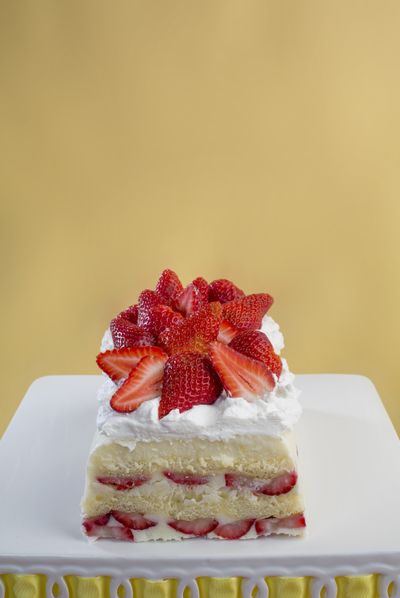Old-school icebox cakes good dessert for Mother’s Day

An icebox cake is totally old-school. And totally perfect for Mother’s Day.
Why? Because when you were a kid, maybe Mom or Grandma helped you arrange vanilla wafers, banana slices and pudding in a pan, slathering it with whipped cream before chilling it. Then you devoured every last sweet bit.
And because it’s a dessert enjoying a renaissance, judging by the uptick in cookbooks on the subject in the past few years, including the latest: “Icebox Cakes: Recipes for the Coolest Cakes in Town” (Chronicle Books, $18.95).
Jessie Sheehan co-wrote the book with Jean Sagendorph and suggests the dessert’s popularity is linked to our appetite for homey, comfort foods: “It’s in the same school as the cupcake phase and the whoopie pie phase.”
Of course, an icebox cake doesn’t use cake. Instead, pudding and whipped cream soften crisp cookies to a cakelike texture. And while the “icebox” became a refrigerator a long time ago, the name has stuck to this dessert with a sweet pedigree; its ancestors include French chef Marie-Antoine Careme’s custard-and-ladyfinger charlotte and England’s trifle.
Credit its creation to a culinary convergence early in the 20th century: Refrigerators became common household appliances, foodmakers began packaging cookies (i.e. Nabisco’s Famous Chocolate Wafer) often with recipes on the package, it was simple to make and newspaper food columnists were developing recipes using what they called “boughten” cookies. As one 1932 story noted, those cookies on their own are “really not half so exciting as serving them as shivery icebox cakes.”
By the 1950s, write Sheehan and Sagendorph, the icebox cake “was the darling of the dessert table.”
Their book goes beyond boughten cookies with recipes for made-from-scratch wafers, graham crackers and ladyfingers layered with puddings, whipped cream or both. And it takes the cake into the 21st century with 25 intriguing recipes, including red velvet, Mexican chocolate spice, chai-ginger, black pepper-rum and lavender-blueberry.
“If you do (an icebox cake) all homemade, it has more texture,” said Sheehan, a baker and recipe developer. “They’re so flavorful because the whipped cream is flavorful and the cookie component is flavorful.
“But I totally get it that people don’t have time,” she added. So the authors suggest choosing a store-bought cookie or ladyfinger with some features of the homemade ones:
Cookies should be thin, dry and crispy (i.e. Nabisco Famous Chocolate Wafers, vanilla wafers, graham crackers, Anna’s Thins). Shortbread and fruit bars are too thick.
Use spongy, not crispy, ladyfingers.
Cakes with store-bought cookies will be ready to eat after five to eight hours of chilling; homemade cookies need a 24-hour chill.
And the fun part? Creating this sweet treat with the kids for Mom.
Strawberry-Lemon Icebox Cake
Adapted from “Icebox Cakes”
1 cup granulated sugar
1/4 cup cornstarch
3/4 teaspoon salt
2 1/2 cups whole milk
3/4 cup whipping cream
1/3 cup fresh lemon juice and 3 tablespoons finely grated lemon zest (from about 3 lemons)
1 egg, lightly beaten
1 tablespoon unsalted butter
1/4 teaspoon lemon extract
24 ladyfingers, or more as needed
3 cups fresh strawberries, hulled, thinly sliced
Lemon whipped cream, see recipe below
For the pudding: Combine granulated sugar, cornstarch and salt in a medium saucepan. Whisk in milk, cream, lemon juice and zest until combined. Add egg; whisk again. Place saucepan over medium-high heat. Cook, whisking constantly. When the mixture begins to thicken and bubbles begin popping on the surface, turn heat to medium and whisk vigorously, 45 seconds. Remove pan from heat.
Strain pudding through a medium-mesh wire sieve into a heatproof bowl. Add butter and lemon extract; whisk until they are incorporated. You should have about 5 cups. Let the pudding cool slightly; it should still be warm and relatively pourable when you layer it with the ladyfingers. Prepare lemon whipped cream.
To assemble cake: Spread a generous layer of pudding on the bottom of an 8-by-8-by-2-inch baking pan. Cover as much of the pudding as possible with a layer of ladyfingers, filling any gaps with broken ladyfingers. The pieces should touch. The goal is a solid layer of ladyfingers.
Set aside about 1/4 cup sliced strawberries for garnish. Layer some remaining strawberries over the ladyfingers. Continue layering in this order (pudding, ladyfingers, strawberries) until you run out or reach the top of the pan, no matter what layer you end on. Spread the top of the cake with whipped cream. Gently cover with plastic wrap. Refrigerate 24 hours. Remove plastic wrap from cake; scatter reserved strawberries on top. Serve directly from pan.
Nutrition information per serving (for 12 servings): 295 calories, 14 g fat, 8 g saturated fat, 99 mg cholesterol, 38 g carbohydrates, 5 g protein, 212 mg sodium, 1 g fiber
Note: The dessert also can be made in 8-by-4-inch loaf pans; you will have enough pudding and strawberries for two. If you want to remove the cake from the pan for serving, line it with plastic wrap before building the layers.
Makes: 9 to 12 servings
Lemon Whipped Cream: Pour 1 1/2 cups whipping cream into a chilled metal bowl; beat on medium with electric beater or in a stand mixer until thickened. Add 3 tablespoons confectioners’ sugar; 1 1/2 tablespoons each fresh lemon juice, finely grated lemon zest and limoncello (an Italian lemon liqueur, optional); and 1/2 teaspoon lemon extract, or to taste. On medium-high, whip cream until it holds stiff peaks that stand upright when the whisk is raised.
Makes: about 3 cups.